Peptide-based research has gained significant traction in recent years, with a focus on synthetic analogs that may influence physiological processes within an organism. Among these, Tesamorelin, CJC-1295 (Mod GRF 1-29), and Ipamorelin have emerged as subjects of interest due to their potential implications in research domains related to endocrinology, metabolism, and cellular function. Investigations purport that these peptides may interact with various biological pathways, prompting speculation regarding their possible role in growth modulation, metabolic regulation, and tissue dynamics. This article explores the speculative mechanisms underlying these peptides and their possible implications for future scientific inquiry.
Tesamorelin: A Synthetic Analog with Metabolic Implications
Tesamorelin, a synthetic growth hormone-releasing hormone (GHRH) analog, has been examined for its potential to modulate metabolic pathways within the organism. Studies suggest that this peptide may interact with the hypothalamic-pituitary axis, where it is theorized to stimulate the release of endogenous growth factors. Research indicates that by engaging with specific receptors, Tesamorelin might influence protein synthesis and lipid metabolism, suggesting its relevance in research focused on energy expenditure and tissue composition.
Recent explorations into Tesamorelin’s properties suggest that it might impact lipid profiles by modulating pathways related to adipose tissue metabolism. It has been hypothesized that this peptide’s interaction with growth-related processes might influence the utilization of stored energy, which may have implications for research involving nutrient partitioning. Additionally, its possible impact on cellular processes has led researchers to investigate potential applications in regenerative biology, particularly in tissue repair and recovery.
CJC-1295 (Mod GRF 1-29): A Stabilized Growth Hormone-Releasing Factor?
CJC-1295 (Mod GRF 1-29) is a modified version of the growth hormone-releasing factor (GRF), designed to have an extended half-life. Investigations purport that the peptide may engage with receptors associated with endogenous growth factor release, thereby influencing protein turnover and cellular renewal. Investigations purport that CJC-1295 might play a role in facilitating tissue maintenance and homeostasis within the organism, leading to speculation regarding its involvement in age-related cellular processes.
One avenue of interest in research involving CJC-1295 pertains to its hypothesized impact on sleep-related recovery mechanisms. Since endogenous growth factor release is closely linked to circadian rhythms, studies indicate that peptides such as CJC-1295 might hold relevance in exploring the connections between sleep cycles and cellular restoration. Furthermore, researchers have theorized that its possible impact on protein metabolism may position it as a candidate for studies into muscular adaptation and structural integrity.
Metabolic research has also begun to explore the potential interactions between CJC-1295 and insulin-like growth factors. It has been suggested that this peptide may play a role in pathways regulating glucose utilization, which has drawn attention to its possible implication in studies on metabolic flexibility. By examining how this peptide influences anabolic and catabolic signaling, researchers aim to elucidate its contributions to organismal energy balance.
Ipamorelin: A Selective Secretagogue with Neuromodulatory Potential
Ipamorelin is a synthetic peptide classified as a selective growth hormone secretagogue. Unlike other secretagogues that might engage with broader receptor systems, Ipamorelin is theorized to exhibit high specificity for receptors involved in growth factor regulation. This selectivity has led to considerations of its relevance within research focusing on organismal development, cellular maintenance, and homeostatic processes.
Additionally, researchers have begun to explore how Ipamorelin may interact with gastrointestinal and immune system processes. The peptide’s possible influence on gut-related signaling pathways is a subject of ongoing inquiry, particularly in relation to nutrient absorption and microbiota interactions. The immune-modulating potential of Ipamorelin is another field of interest, with studies suggesting that it may contribute to discussions on inflammatory balance within the organism.
Research Domains of CJC-1295, Tesamorelin and Ipamorelin
Given the biochemical potential of Tesamorelin, CJC-1295 (Mod GRF 1-29), and Ipamorelin, these peptides have been positioned as subjects of interest in various research fields, including endocrinology, metabolic science, and regenerative biology. Studies suggest that these compounds may provide insights into the mechanisms governing homeostasis, tissue dynamics, and molecular adaptation.
In the field of cellular aging, speculative research exists regarding the involvement of these peptides in cellular turnover and longevity-related pathways. It has been hypothesized that their interactions with growth factor regulation may shed light on processes underlying organismal resilience. Additionally, investigations purport that these peptides might contribute to discussions on physiological adaptation in response to environmental stimuli, including variations in nutrition and physical exertion.
Conclusion
Tesamorelin, CJC-1295 (Mod GRF 1-29), and Ipamorelin continue to be of considerable interest in scientific exploration, with their hypothesized roles in metabolic modulation, cellular maintenance, and neurobiological adaptation. Their interactions with various biological pathways suggest potential implications across multiple domains, including endocrinology, regenerative science, and physiological research. While much remains to be investigated, current inquiries into these peptides may offer valuable insights into fundamental biological processes, shaping the direction of future research initiatives. Researchers interested in finding out more about Tesamorelin, CJC-1295, and Ipamorelin are encouraged to read this study.
References
[i] Teichman, S. L., Neale, A., Lawrence, B., Gagnon, C., Castaigne, J. P., & Frohman, L. A. (2006). Prolonged stimulation of growth hormone (GH) and insulin-like growth factor I secretion by CJC-1295, a long-acting analog of GH-releasing hormone, in healthy adults. The Journal of Clinical Endocrinology & Metabolism, 91(3), 799-805. https://doi.org/10.1210/jc.2005-1536
[ii] Falutz, J., Allas, S., Blot, K., Potvin, D., Kotler, D., Somero, M., Berger, D., Brown, S., & Richmond, G. (2007). Metabolic effects of a growth hormone–releasing factor in patients with HIV. The New England Journal of Medicine, 357(23), 2359-2370. https://doi.org/10.1056/NEJMoa072291
[iii] Devesa, J., Casteleiro, N., Piñeiro, C., & Devesa, P. (2016). The role of growth hormone on adult hippocampal neurogenesis. Cell & Tissue Research, 364(1), 41-55. https://doi.org/10.1007/s00441-015-2280-2
[iv] Bowers, C. Y., Momany, F. A., Reynolds, G. A., & Hong, A. (1984). On the in vitro and in vivo activity of a new synthetic hexapeptide that acts on the pituitary to specifically release growth hormone. Biochemical and Biophysical Research Communications, 121(2), 476-481. https://doi.org/10.1016/0006-291X(84)91216-6
[v] Smith, R. G., & Sun, Y. (2004). Developments in ghrelin biology and potential clinical relevance. Trends in Endocrinology & Metabolism, 15(9), 436-441. https://doi.org/10.1016/j.tem.2004.09.008















